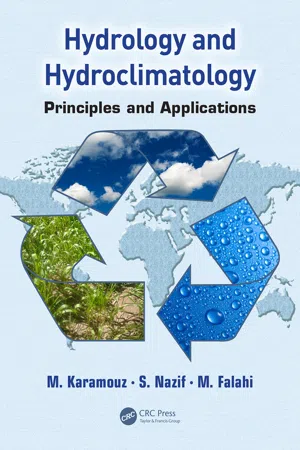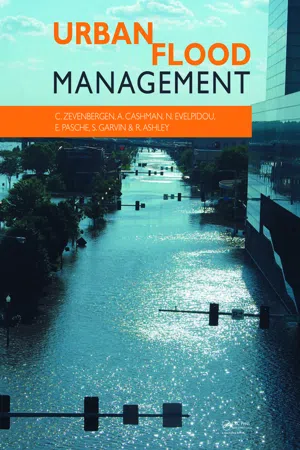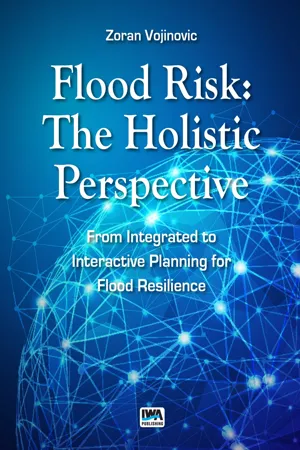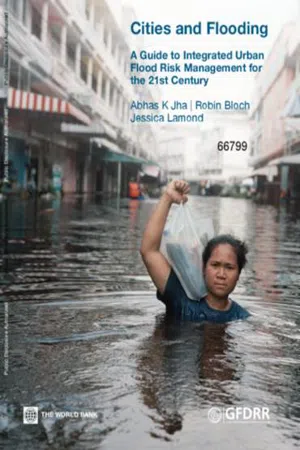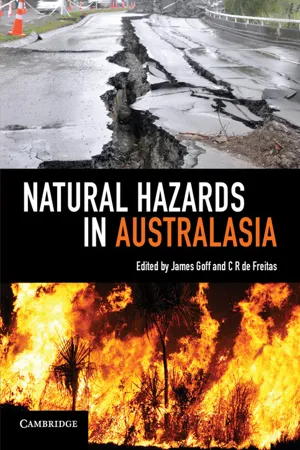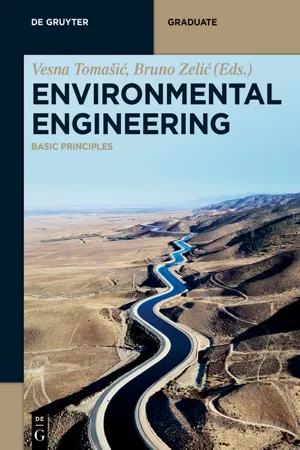Geography
Floods
Floods are natural disasters characterized by the overflow of water onto land that is usually dry. They can result from heavy rainfall, snowmelt, or the overflow of rivers and oceans. Floods can cause extensive damage to infrastructure, homes, and agriculture, and pose significant risks to human life and safety.
Written by Perlego with AI-assistance
Related key terms
1 of 5
10 Key excerpts on "Floods"
- eBook - PDF
Hydrology and Hydroclimatology
Principles and Applications
- M. Karamouz, S. Nazif, M. Falahi(Authors)
- 2012(Publication Date)
- CRC Press(Publisher)
651 13 Flood 13.1 INTRODUCTION Flood is an overflow of an expanse of water that covers the land not normally covered by water. This water can come from the sea, lakes, rivers, canals, or sewers as well as rainwater. There are seasonal and intra-annual variations in river flow resulting in very high flow periods, but Floods are considered to happen when the excess rainfall (runoff) escapes the boundaries of the flowing water body and damages the surrounding area used by humans like a village, city, or other inhabited area. Flooding is caused primarily by hydrometeorological mechanisms, acting either as a single factor or in combination with different factors. Whatever the type of flooding, the phenomenon can always be described as a volume of water that enters a certain area that cannot be discharged quickly enough. As a consequence, therefore, the water level rises and flooding occurs. Floods in coastal areas, which are enhanced by sea level rise, especially in coastal regions of the United States, Japan, and southeastern parts of Asia, cause serious damage to human societies. Most urban areas are subject to some kinds of flooding after spring rains, heavy thunderstorms, or winter snow thaws because of high percentages of imperviousness. A variety of structures such as dams, levees, bunds, and weirs are employed in order to control the Floods and decrease the damage. However, Floods continue to be the most destructive natural hazards in terms of short-term damage and economic losses to a region. The large damage caused by Floods are due to the short warning time before flooding occurs, which makes it difficult to move people and valuable moveable prop-erties from the flooding area. According to the Federal Emergency Management Agency (FEMA) of the United States, Floods are the second most common and widespread of all natural disasters (drought is first globally). - eBook - PDF
- Chris Zevenbergen, Adrian Cashman, Niki Evelpidou, Erik Pasche, Stephen Garvin, Richard Ashley(Authors)
- 2010(Publication Date)
- CRC Press(Publisher)
Runoff and Floods are themselves influenced by geomorphological, spatial and social factors. Floods are associated with natural abnormal events often referred to as extreme events that are area specific, whether the area is highly localised or extensive. The common factor of such areas is that they are associated with catchment areas and river basins. Such areas can be rural, urban or a combination of both. The idea of Floods as disas-ters though is an anthropogenic concept, they are a disaster because of the adverse and 2.1 THE INFLUENCE OF CLIMATE AND OTHER FACTORS 40 unlooked for impacts that they have on the functioning of human society. Floods are therefore a natural phenomena and it is a human construct to label flooding as being acceptable or not. One of the most important factors affecting this is the discharge rate of open channels such as rivers and streams and is correlated with the maximum discharge that can be routed through without causing out of channel flow within a catchment basin. The flow of water within a river catchment basin is mainly dominated by the infiltration ratio— the amount of water absorbed by the soil and which, as a consequence, acts as a barrier for any further downward water movement within the soil. Several factors determine the infiltration ratio: l soil saturation: correlated with the height of the water table in the soil; l vegetation cover: the type and extent of cover may act as a natural flow barrier, influ-encing infiltration and transpiration as well as surface flow velocities; l soil type: affects the absorptive capacity, clay soils for example are generally impermeable; l frozen ground: only small amounts of water can penetrate frozen ground; l human construction: can ‘harden’ natural surfaces, preventing infiltration and increasing runoff. - eBook - PDF
Flood Risk
The Holistic Perspective
- Zoran Vojinovic(Author)
- 2015(Publication Date)
- IWA Publishing(Publisher)
1.1 SETTING THE SCENE Floods are commonly defined as an overwhelming flow of water onto land that is normally dry and which under certain circumstances can cause unprecedented losses and devastation. The argument put forward in this book is that these losses are often the result of a wide range of interactions between different actors and processes which can be natural, human and technology related. Therefore, flood-related problems should be viewed from as many different perspectives as possible before a way of dealing with them is selected. The purpose of the discussion in this opening chapter is to illustrate the complexity of flood-related problems and to suggest the way forward. According to the International Disaster Database (EM-DAT), over the last seventy years, the incidence of Floods has shown the fastest rate of increase relative to other types of disasters (see also Guha-Sapir et al. 2012), Figure 1.1. Devastation due to these events occurs almost daily. Even though our technological capabilities for dealing with Floods have advanced rapidly over the same period, and while global economic growth per capita has doubled, flood events have become ever more disastrous (see for example, Pelling, 2011). Does this mean that our technological developments have advanced independently from the social and wider ecological needs? This paradoxical situation can be viewed as a result of our narrow and fragmented perception of reality which has proved to be inadequate for dealing with some of the greatest problems of our time. As pointed out some time ago by Burton and Kates (1964), the perception of Floods and other natural disasters as ‘those elements of the physical environment harmful to man and caused by forces extraneous to him’ has led to the preference for physical rather than social treatment of Floods, with urban societies being allowed to live under the shadow of increasing risk. - eBook - PDF
Geomorphology and Natural Hazards
Proceedings of the 25th Binghamton Symposium in Geomorphology, Held September 24-25, 1994 at SUNY, Binghamton, USA
- M. Morisawa(Author)
- 2013(Publication Date)
- Elsevier Science(Publisher)
Floods are part of a very broad range of water-related phenomena that have immense impacts upon human beings. These phenomena exert their influence on human affairs mainly through concerns about water supply and hazard reduction. It is out of such concerns, rather than inherent curiosity, that society provides resources for research on hydrological processes. The designs that serve to bring research results into practice are the products of various water engineers, and engi-neering philosophies have until recently dominated hydrological research. Due in part to heightened rec-ognition of global environmental problems, however, there is a current initiative to emphasize ' 'fundamental hydrologic science... as a geoscience alongside the atmospheric, ocean, and solid earth sciences (National Research Council, 1991). Critical to the rationale for this new emphasis is the relationship of water geoscience to the world of human affairs: water resources management and decision making. The role of geomorphology in this conceptualization (National Research Council, 1991, p. xi) is to be one of many disciplines concerned with understanding water phe-nomena (hydrologic science). When combined with statistics, fluid mechanics, meteorology, and other fundamentals, these sciences provide the basis in understanding for forecasting, which is stated to be the proper role for engineering hydrology. The forecasting role can then be combined with economics, law, polit-ical science, and resource sciences to justify decisions by water-resource managers. Of course, this is business as usual. In this regard, let us consider a possible model forecast, expressing a high flood risk for a certain site. Suppose that the model 150 V.R. Baker / Geomorphology 10 (1994) 139-156 Fig. 3. Destruction of apartment buildings by bank erosion of Rillito Creek, Tucson, Arizona, October 2, 1983. Photograph by S. Reynolds, Arizona Geological Survey. - eBook - PDF
Cities and Flooding
A Guide to Integrated Urban Flood Risk Management for the 21st Century
- Abhas K. Jha, Robin Bloch, Jessica Lamond(Authors)
- 2012(Publication Date)
- World Bank(Publisher)
Instead of implementing conventional hard engineering measures to control Floods in the Yangtze River, the Government adopted a new approach that includes restoration of 14,000 km2 of natural wetlands by 2030. Floodplain restoration is a flexible, no regret approach that will be cost- effective regardless of changes in future flood risk. Source: Pittock and Xu 2011. 60 1.2.3. Pluvial or overland Floods Pluvial Floods also known as overland Floods are caused by rainfall or snowmelt that is not absorbed into the land and flows over land and through urban areas before it reaches drainage systems or watercourses. This kind of flooding often occurs in urban areas as the lack of permeability of the land surface means that rainfall cannot be absorbed rapidly enough, flooding results. Pluvial Floods are often caused by localized summer storms or by weather conditions related to unusually large low pressure areas. Characteristically, the rain overwhelms the drainage systems, where they exist, and flows over land towards lower-lying areas. These types of Floods can affect a large area for a prolonged period of time: the 2007 Floods in the Hull area in the UK were the result of prolonged rainfall onto previously saturated terrain which overwhelmed the drainage system and caused overland flooding in areas of the city outside the fluvial floodplain. Pluvial Floods may also occur regularly in some urban areas, particularly in tropical climates, draining away quickly but happening very frequently, even daily, during the rainy season. 1.2.4. Coastal Floods Coastal Floods arise from incursion by the ocean or by sea water. They differ from cyclic high tides in that they result from an unexpected relative increase in sea level caused by storms or a tsunami (sometimes referred to as a tidal wave) caused by seismic activities. - eBook - PDF
- James Goff, C. R. de Freitas(Authors)
- 2016(Publication Date)
- Cambridge University Press(Publisher)
Flooding occurs in all climatic regions of Australasia. Unlike many other natural hazards, their frequency puts them high in importance on the list of natural hazards for most countries. A combination of factors is responsible, mostly but not entirely due to weather and climate. Heavy rainfall is implicated in causing a flood, but vulnerability to flood loss is generated by human action. Types of flood damage include injuries and loss of life, physical damage, income loss (including indirect losses), emergency costs, and social disruption. Measures for reducing the impacts of Floods fall into one or more of five categories of response: avoidance, protection, regulation, relocation, compensation and education. Watershed and floodplain management is a multi-faceted approach that involves all of these categories of responses aimed at decreasing the effects of flooding. When similar physical events are described as hazards, quite different features may become important. Take, for example, the urban snow hazard. The threshold for a crippling snowfall in Toronto, Canada, is higher than the threshold for the even colder Canadian city of Regina (de Freitas 1975 ). Therefore, a snow storm producing 20 cm of snow will cause much more disruption in Regina than in Toronto. This is because the physical character of a snowfall event involves more than just snowfall amount. The snow water equivalent and the air temperature and wind speed at the time of the snowfall event need to be considered alongside snow accumulation. To understand and explain the human response to snowfall and its impact, a number of other snowfall hazard event characteristics are also important (de Freitas 1975 ). This applies to all natural hazards. The physical significance of the flood event may be gained only by taking into account the combined effects of hazard event characteristics. - eBook - PDF
- Muthukrishnavellaisamy Kumarasamy(Author)
- 2012(Publication Date)
- IntechOpen(Publisher)
The likelihood of increasing frequency of heavy precipitation events is assessed as ’likely’ for the last four decades of the 20th century and ’very likely’ for the 21st century. This also means that over most regions of the Earth’s land surface an ever growing proportion of total precipitation will fall in the form of heavy rainfalls (Burroughs, 2003). The intensification trend of tropical cyclone activity, observed in some regions since 1970, will probably also continue in the 21st century. As a consequence, rainfall events concentrated in time and space are expected to lead to serious local flooding in many parts of the world. Floods are remarkable hydrometeorological phenomena and forceful agents of geomorphic evolution in most physical geographical belts and, from the viewpoint of human society, among the most important environmental hazards. Except for extreme environments, floodplains and the immediate surroundings of streams are usually densely inhabited areas and, therefore, they are of high vulnerability to Floods. According to the European Environment Agency (EEA, 2010), Floods rank as number one on the list of natural disasters in Europe over the past decade. Authors of the report claim that ”the events resulting in the largest overall losses were the Floods in Central Europe (2002, over EUR 20 billion), in Italy, France and the Swiss Alps (2000, about EUR 12 billion) and in the United Kingdom (2007, over EUR 4 billion)” (p. 8.). With accumulating knowledge on the water regime of major rivers, the inundation hazard from riverine Floods can be defined with some precision. To estimate the magnitude of this hazard in small catchments, however, poses more problems. 2. Flash flood research 2.1 Definitions and approaches Flash Floods (synonym: storm-driven Floods) can be defined from various aspects: as hydrometeorological phenomena, natural hazards or geomorphic agents. - eBook - PDF
Floods, from Defence to Management
Symposium Proceedings of the 3rd International Symposium on Flood Defence, Nijmegen, The Netherlands, 25-27 May 2005, Book + CD-ROM
- Jos van Alphen, Eelco van Beek, Marco Taal(Authors)
- 2006(Publication Date)
- CRC Press(Publisher)
The latter category of events often includes flash Floods with relative high direct and indirect economic losses; • So far no clear and generally approved assessment methodologies for economic and social impacts are available. Data is collected by different agencies and retrieved from different sources. Especially in least developed countries, damage assessments appear to be rough estimates at best; • In case of cyclones and hurricanes it is extremely difficult to distinguish casualties who fell from collapsing trees, buildings and other structures and to determine whether damages and economic losses have been incurred by strong winds or by flooding; • The increasing knowledge on Floods and flooding is contributing to the seemingly increasing vulner-ability of societies. These knowledge related fac-tors are significant and include for instance the length of data records and improving reports of flooding, meaning that more events are reported. In general, flooding only causes problems when it adversely affects human societies. Nowadays around one billion people, the majority of them among the world’s poorest inhabitants, are living in the potential path of a 100-year flood (EO News, 2004). Therefore analysing Floods and flooding implies not only taking natural driving forces into account but also human behaviour. There are many inter-linked factors respon-sible for the occurrence of Floods. Direct anthropogenic interferences by occupation, developments and invest-ments in flood prone areas and changing land-use, and indirectly by influencing the climate on a global scale, makes a sound analysis rather complicated (Myers, 1997). There is little or no doubt that societies as a whole have become more vulnerable to extreme weather events (Kunkel et al., 1999). - eBook - PDF
Wetland Ecology
Principles and Conservation
- Paul A. Keddy(Author)
- 2010(Publication Date)
- Cambridge University Press(Publisher)
2 Flooding Water creates wetlands. The most important causal factor that we need to study is therefore water. The biological composition of the wetland, from its fish to its birds, from its plants to its insects, depends upon the way in which water moves through the wetland. Timing and rate of flow are critical. In most landscapes there tend to be drier periods interrupted by pulses of flooding after rainfall or when snow melts. The more we study wetlands, the more we find that these cycles of flooding, also called flood pulses, are critical to understanding wetlands. There is an entire scientific discipline of hydrology, that addresses the occurrence, distribution, and movement of water (Ward and Trimble 2004 ; Brutsaert 2005 ). Here we shall focus on flooding. The amplitude and frequency of water level fluctuations are probably the most important factors affecting the composition and function of wetlands. Water levels change over many timescales – the annual cycle of flooding is the most obvious, but there is also change from one year to the next. Let us begin, then, by considering these two sources of variation, flooding within and among years. Within years Pictures of flooding ( Figure 2.1 ) are a vivid reminder that flow rates change with the time of year in rivers around the world ( Figure 2.2 ). High water periods or pulses (Middleton 2002 ) are natural and entirely predictable events. In the temperate zone pulses are produced each spring by the rapid melting of the accumulated precipitation of an entire winter. In tropical and subtropical rivers pulses are usually caused by rainy seasons such as monsoons. The size of pulses is often remarkable – the Amazon River, which carries approximately one-fifth of the Earth’s total freshwater runoff, can change level by more than 10 m within a single year! Among years There are also pronounced differences in water levels from one year to the next in most wetlands. - eBook - ePub
Environmental Engineering
Basic Principles
- Vesna Tomašić, Bruno Zelić, Vesna Tomašić, Bruno Zelić(Authors)
- 2018(Publication Date)
- De Gruyter(Publisher)
Earthquakes and volcanoes are caused by internal earth processes, i. e. by plate tectonic. Plate boundaries are the places where most of these natural hazards happen. On the other hand, external processes, such as weathering and sedimentation that are caused by sun, water, ice, wind, atmosphere, and organisms, shape the earth surface and cause natural hazards such as Floods and mass movements (e. g. landslides, rock falls, subsidence, mudflows). Main activities important for prediction and risk assessment are investigation of past natural processes happened in the area, as well as monitoring of certain parameters (e. g. emanation of gasses in earthquake and volcanic activity prone areas). Hereinafter, flood as natural hazard is presented in more detail.5.1.1 Hydrological cycle
Hydrological cycle, or water cycle, refers to circulation of water in nature (Figure 5.1 ). The water moves in different phases through atmosphere, over and below the land to the oceans and back to the atmosphere. As the atmospheric water vapour condense, it precipitates over the land in form of rain, snow, dew, frost etc., and moistens the surface. Some of that water evaporates. Remaining portion of water remains on the surface as surface runoff or enters into the soil as infiltration. Water increases soil moisture in unsaturated zone and finally reaches ground water level and groundwater. As the surface runoff increases, water tends to accumulate in puddles and ponds as depression storage, or in channels and gullies where it forms streamflow. Streamflow also drains from groundwater, and ultimately ends up in large water bodies, such as lakes and oceans. Because of sun radiation, wind and adequate air humidity, surface water evaporates from precipitation, wet vegetation, puddles and lakes, soil, streams and large water bodies back into the atmosphere where it forms clouds, thus closing hydrological cycle.Figure 5.1: Hydrological cycle.5.1.1.1 Water in the atmosphere
The scientific discipline that studies the water in the atmosphere is called meteorology. It is a branch of earth sciences that study the physical processes and phenomena of the earth’s atmosphere. Hydrometeorology is the scientific discipline related to hydrology that studies the physical processes in the atmosphere and on the earth within the hydrological cycle.
Index pages curate the most relevant extracts from our library of academic textbooks. They’ve been created using an in-house natural language model (NLM), each adding context and meaning to key research topics.
